1. From where does the starting energy in a food chain come?
A) water
B) consumers
C) sunlight
D) producers
C) sunlight
. A farmer wants to grow more plants. The farmer uses a chemical fertilizer. It helps plants grow but pollutes a river. The farmer tries a natural fertilizer instead.
Did the farmer succeed in growing more plants without hurting the river?
 A) Yes. The natural fertilizer caused more plants to grow.
A) Yes. The natural fertilizer caused more plants to grow.
B) No. The natural fertilizer polluted the river with harmful germs.
C) No. The natural fertilizer harmed the river and the plants.
D) Yes. There are fewer chemicals in the nearby river.
B) No. The natural fertilizer polluted the river with harmful germs.
Wild hogs are non-native species that prey on reptile eggs and destroy habitats.
Which claim is best supported?
A) Adding a new animal to an environment can be harmful to other animals already living there.
B) Replacing an animal in an environment can be helpful to other animals already living there.
C) Increasing an animal population can be helpful by repairing environmental damage.
D) Removing an animal population can be harmful by causing damage.
A) Adding a new animal to an environment can be harmful to other animals already living there.
The pictograph shows light- and dark-colored snails found in a snowy area.
Why is the number of light and dark snails different?

A) The light color allows the snails to see each other in the snow.
B) The light color allows the snails to find more food.
C) The dark color allows snails to absorb more heat from the environment.
D) The dark color allows snails to hide from danger in the snow.
C) The dark color allows snails to absorb more heat from the environment.
Which observation would most likely suggest that a region had a wet environment in the past?
A) fossils of birds and lizards
B) fossils of dinosaurs and large trees
C) fossils of camels and cacti
D) fossils of fish and aquatic plants
D) fossils of fish and aquatic plants
 Study the food chain.
Study the food chain.
How is the newt classified?
A) producer
B) decomposer
C) herbivore
D) consumer
D) consumer
Human-made dams are important for water management and creating electricity, but they can harm aquatic life.
Which example shows how dam technology has been modified to decrease the risk to the environment?
A) Install fish ladders alongside dams so fish can get past the dams.
B) Build taller dams to increase water storage.
C) Release large amounts of water at different times, causing sudden river level changes.
D) Build dams so only water can make it to the other side.
A) Install fish ladders alongside dams so fish can get past the dams.
Study the food web.
Which will likely happen to the seagull population if the squid population declines?

A) The seagull population will eat more seals.
B) The seagull population will eat less seals.
C) The seagull population will eat less krill.
D) The seagull population will eat more krill.
C) The seagull population will eat less krill.
The table shows the effect of different factors on Engelmann spruce seedling survival.
Which can likely be concluded?
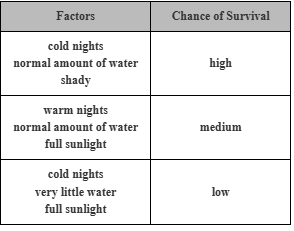 A)If less water is available, fewer seedlings will survive.
A)If less water is available, fewer seedlings will survive.
B) If nights become warmer, more seedlings will survive.
C) If the area becomes shadier, fewer seedlings will survive.
D) If the daytime temperature increases, more seedlings will survive.
A)If less water is available, fewer seedlings will survive.
The image shows a fossil of a ground sloth found in bitumen.
Which two sentences explain why it’s considered a fossil?
A) The ground sloth kept in bitumen only occurs in nature.
B) The remains are found in the top layer of the ocean.
C) The ground sloth was an ancient organism.
D) The remains were preserved by natural processes.
E) The ground sloth can only be preserved in bitumen.
✅ C) The ground sloth was an ancient organism.
✅ D) The remains were preserved by natural processes.
The table shows information about organisms in a desert.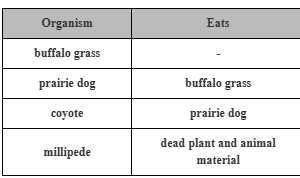 Which is a difference between a consumer and a decomposer?
Which is a difference between a consumer and a decomposer?
A) A consumer hunts for food. A decomposer makes its own food.
B) A consumer eats living organisms. A decomposer breaks down dead material.
C) A consumer lives below the ground. A decomposer lives above the ground.
D) A consumer is a living organism. A decomposer is not a living organism.
B) A consumer eats living organisms. A decomposer breaks down dead material.
Which is the best example of an organism’s physical appearance changing as its environment changes?
A) a fish moving to a deeper lake part when
B) a rabbit population growing larger in number after food changes
water level drops
C) holly leaves growing spines after deer eat them
D) a bird species leaving a forest due to less food
C) holly leaves growing spines after deer eat them
Sugarcane is a crop grown for sugar. Cane toads were introduced to eat insects damaging crops, but they also eat lizards and make animals sick.
How will cane toads affect the ecosystem?

A) The cane toads will harm the ecosystem by making it harder for snakes and frogs to find food.
B) The cane toads will help the ecosystem because they will remove insects and small lizards.
C) The cane toads will harm the ecosystem by causing an increase in grasses and eucalyptus trees.
D) The cane toads will help the ecosystem because they will protect frogs from predators.
a) The cane toads will harm the ecosystem by making it harder for snakes and frogs to find food.
The diagram shows a food chain from an ecosystem.

Which two statements best describe the movement of matter?
A) Matter moves from consumer to producer when phytoplankton is eaten by the bristle worm.
B) Matter enters the food chain when phytoplankton makes food using sunlight.
C) Matter enters the food chain when the bull shark makes food.
D) Matter moves from producer to consumer when phytoplankton is eaten by the bristle worm.
B) Matter enters the food chain when phytoplankton makes food using sunlight.
D) Matter moves from producer to consumer when phytoplankton is eaten by the bristle worm.
Atlantic cod live in cold water. Over 80 years, water warmed and cod numbers dropped.
What’s the best way cod can improve survival?
a)increase body temperature to adapt
b) change their body shape to keep temperature low
C) grow a thick layer around them
D) move to areas with cooler water
D) move to areas with cooler water
The image shows a food web of an ecosystem with a location labeled X.

Which will be the likely effect if an invasive species moves into the ecosystem and has location X in the food web?
A) The orca population will decrease.
B) The penguin population will increase.
C) The krill population will decrease.
D) The seal population will increase.
A) The orca population will decrease.
Scientists found fossil leaves and shells in desert rock layers.
Which sentence best explains how the environment changed?
A) The area was always a desert; fossils were carried there by wind and floods.
B) The area changed from forest → shallow marine → desert.
C) The area was a marine environment first, then forest, then desert.
D) The area was a coastal region with a mix of land and marine habitats.
C) The area was a marine environment first, then forest, then desert.
The diagram shows a food chain in a Tennessee ecosystem.
What will likely happen if the coyotes are removed?

A) The grass population will increase because fewer deer will eat it.
B)The population of deer will decrease due to increased grass growth.
C) The population of deer will increase due to less food available.
D) The population of grass will decrease because more deer will eat it.
D) The population of grass will decrease because more deer will eat it.
What is the role of a decomposer in an ecosystem?
A) to help other animals find food
B) to produce food from sunlight
C) to eat living plants and animals
D) to break down dead organisms
D) to break down dead organisms
The table shows two butterfly species over five years as the environment changed.
Which statement best explains what happened?
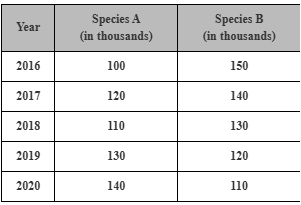 A) Species B is better suited to the changing environment, but Species A struggles.
A) Species B is better suited to the changing environment, but Species A struggles.
b) Species A is better suited to the changing environment, but Species B struggles.
c) Both species can survive the environmental changes and increase in numbers.
d) Neither species can survive the environmental changes and both decrease.
b) Species A is better suited to the changing environment, but Species B struggles.
Which type of organisms plays a key role in returning nutrients to the soil?
A) Decomposer
B) Producer
C) Omnivore
D) Carnivore
A) Decomposer
A mammoth was found in snowy regions. Based on the table, which fossil was it likely found in?
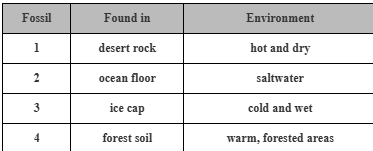 A) Fossil 4
A) Fossil 4
B) Fossil 3
C) Fossil 1
D) Fossil 2
B) Fossil 3
The food web shows a forest ecosystem.
A disease decreases the deer population. Why might this cause less harm than if deer were the only plant-eating animals?

A) Rabbits provide another food source for wolves and coyotes.
B) Wolves will start eating grass.
C) The dead deer will cause an increase in decomposers.
D) Coyotes will begin to eat grass.
A) Rabbits provide another food source for wolves and coyotes.
The chart lists what Arctic foxes and collared lemmings eat. Artic foxes eat collared lemmings and earthworms. Collared lemmings eat bear sedge, lichen, and earthworms.
Which food web correctly shows the relationships?
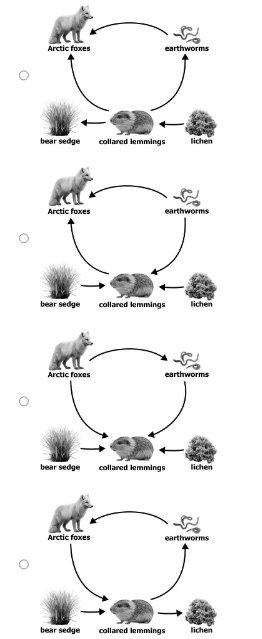 A)A
A)A
B)B
C)C
D) D
B
The diagram shows dinosaur footprints in sandstone but not in limestone.
Which statement is best supported?

A) The dinosaur was alive before the area was covered by an ocean.
B) The dinosaur was not alive before the area was covered by an ocean.
C) The dinosaur was alive when the area was covered by an ocean.
D) The dinosaur was not alive when the sand was on the beach.
A) The dinosaur was alive before the area was covered by an ocean.